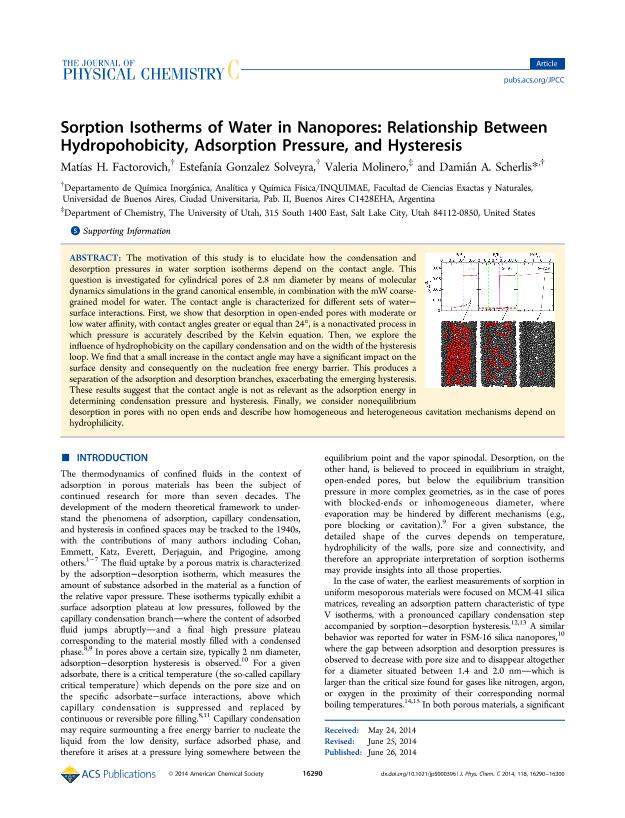Mostrar el registro sencillo del ítem
dc.contributor.author
Factorovich, Matias Hector

dc.contributor.author
Gonzalez Solveyra, Estefania

dc.contributor.author
Molinero, Valeria
dc.contributor.author
Scherlis Perel, Damian Ariel

dc.date.available
2017-12-27T20:07:50Z
dc.date.issued
2014-06
dc.identifier.citation
Scherlis Perel, Damian Ariel; Molinero, Valeria; Gonzalez Solveyra, Estefania; Factorovich, Matias Hector; Sorption Isotherms of Water in Nanopores: Relationship Between Hydropohobicity, Adsorption Pressure, and Hysteresis; American Chemical Society; Journal of Physical Chemistry C; 118; 29; 6-2014; 16290-16300
dc.identifier.issn
1932-7447
dc.identifier.uri
http://hdl.handle.net/11336/31745
dc.description.abstract
The motivation of this study is to elucidate how the condensation and desorption pressures in water sorption isotherms depend on the contact angle. This question is investigated for cylindrical pores of 2.8 nm diameter by means of molecular dynamics simulations in the grand canonical ensemble, in combination with the mW coarse-grained model for water. The contact angle is characterized for different sets of water–surface interactions. First, we show that desorption in open-ended pores with moderate or low water affinity, with contact angles greater or equal than 24°, is a nonactivated process in which pressure is accurately described by the Kelvin equation. Then, we explore the influence of hydrophobicity on the capillary condensation and on the width of the hysteresis loop. We find that a small increase in the contact angle may have a significant impact on the surface density and consequently on the nucleation free energy barrier. This produces a separation of the adsorption and desorption branches, exacerbating the emerging hysteresis. These results suggest that the contact angle is not as relevant as the adsorption energy in determining condensation pressure and hysteresis. Finally, we consider nonequilibrium desorption in pores with no open ends and describe how homogeneous and heterogeneous cavitation mechanisms depend on hydrophilicity.
dc.format
application/pdf
dc.language.iso
eng
dc.publisher
American Chemical Society

dc.rights
info:eu-repo/semantics/openAccess
dc.rights.uri
https://creativecommons.org/licenses/by-nc-sa/2.5/ar/
dc.subject
Capillary Condesation
dc.subject
Nanopores
dc.subject
Hydriphobicity
dc.subject
Cavitation
dc.subject.classification
Otras Ciencias Químicas

dc.subject.classification
Ciencias Químicas

dc.subject.classification
CIENCIAS NATURALES Y EXACTAS

dc.title
Sorption Isotherms of Water in Nanopores: Relationship Between Hydropohobicity, Adsorption Pressure, and Hysteresis
dc.type
info:eu-repo/semantics/article
dc.type
info:ar-repo/semantics/artículo
dc.type
info:eu-repo/semantics/publishedVersion
dc.date.updated
2017-12-27T15:22:57Z
dc.journal.volume
118
dc.journal.number
29
dc.journal.pagination
16290-16300
dc.journal.pais
Estados Unidos

dc.description.fil
Fil: Factorovich, Matias Hector. Consejo Nacional de Investigaciones Científicas y Técnicas. Oficina de Coordinación Administrativa Ciudad Universitaria. Instituto de Química, Física de los Materiales, Medioambiente y Energía. Universidad de Buenos Aires. Facultad de Ciencias Exactas y Naturales. Instituto de Química, Física de los Materiales, Medioambiente y Energía; Argentina
dc.description.fil
Fil: Gonzalez Solveyra, Estefania. Consejo Nacional de Investigaciones Científicas y Técnicas. Oficina de Coordinación Administrativa Ciudad Universitaria. Instituto de Química, Física de los Materiales, Medioambiente y Energía. Universidad de Buenos Aires. Facultad de Ciencias Exactas y Naturales. Instituto de Química, Física de los Materiales, Medioambiente y Energía; Argentina
dc.description.fil
Fil: Molinero, Valeria. University of Utah; Estados Unidos
dc.description.fil
Fil: Scherlis Perel, Damian Ariel. Consejo Nacional de Investigaciones Científicas y Técnicas. Oficina de Coordinación Administrativa Ciudad Universitaria. Instituto de Química, Física de los Materiales, Medioambiente y Energía. Universidad de Buenos Aires. Facultad de Ciencias Exactas y Naturales. Instituto de Química, Física de los Materiales, Medioambiente y Energía; Argentina
dc.journal.title
Journal of Physical Chemistry C

dc.relation.alternativeid
info:eu-repo/semantics/altIdentifier/doi/http://dx.doi.org/10.1021/jp5000396
dc.relation.alternativeid
info:eu-repo/semantics/altIdentifier/url/http://pubs.acs.org/doi/10.1021/jp5000396
Archivos asociados
